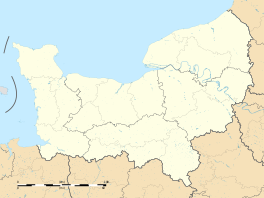Houlgate
| Houlgate | |||
|---|---|---|---|

Town hall
|
|||
|
|||
| Coordinates: 49°18′N 0°05′W / 49.30°N 0.08°WCoordinates: 49°18′N 0°05′W / 49.30°N 0.08°W | |||
| Country | France | ||
| Region | Normandy | ||
| Department | Calvados | ||
| Arrondissement | Lisieux | ||
| Canton | Dozulé | ||
| Intercommunality | Estuaire de la Dives | ||
| Government | |||
| • Mayor (2008–2014) | Jean-Claude Pupin | ||
| Area1 | 4.69 km2 (1.81 sq mi) | ||
| Population (2013)2 | 2,135 | ||
| • Density | 460/km2 (1,200/sq mi) | ||
| Time zone | CET (UTC+1) | ||
| • Summer (DST) | CEST (UTC+2) | ||
| INSEE/Postal code | 14338 /14510 | ||
| Elevation | 0–124 m (0–407 ft) (avg. 5 m or 16 ft) |
||
|
1 French Land Register data, which excludes lakes, ponds, glaciers > 1 km² (0.386 sq mi or 247 acres) and river estuaries. 2Population without double counting: residents of multiple communes (e.g., students and military personnel) only counted once. |
|||
1 French Land Register data, which excludes lakes, ponds, glaciers > 1 km² (0.386 sq mi or 247 acres) and river estuaries.
Houlgate (pronounced: [ulɡat]) is a small tourist resort in northwestern France along the English Channel with a beach and a casino. It is a commune in the Calvados department in the Normandy region.
Houlgate developed as a hamlet in the commune of Beuzeval. Up until the 19th century, Beuzeval consisted of only a few small houses and farms. On the southern side of the stream was Le Hameau de la Mer, consisting of a few houses, a tile and brick works and a water mill. In 1793, only 204 inhabitants lived in the commune.
Between 1845 and 1850, sea bathing became popular in Beuzeval. The Pilter family opened the first guesthouse for poorer protestant families in 1851 on Rue Sébastien-de-Neufville. Numbers of tourists gradually increased, first from Caen and then Paris and so a wooden boarding house was built. The sea-side village was named Beuzeval-les-Bains and attracted much Protestant gentry. The population increased from the 1860s onwards: 270 inhabitants en 1851, 345 in 1861, 515 in 1872 and 1 011 in 1881.
The north bank of the Drochon, larger and flatter, was still undeveloped. A company called the Société de Construction Immobilière (S.C.I.) was formed in 1858 to develop that area of Beuzeval. The company was formed by three men, a financier, a lawyer and a member of parliament, who bought most of the land, divided it into properties, drew the lines for streets and built a wall protecting the developing town from the sea. Within a few years large villas (then called chalets) were built and the quality of build can be seen now as most of these properties still exist.
...
Wikipedia




